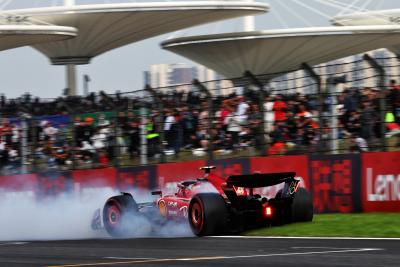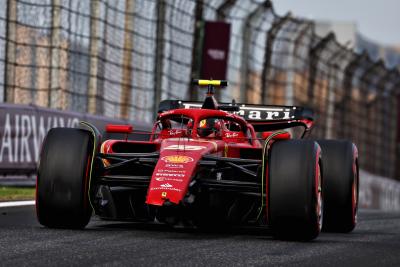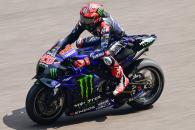Chinese GP qualifying result stands after Aston Martin's protest dismissed
Aston Martin have seen their protest over the results of Chinese Grand Prix qualifying dismissed.
Aston Martin's protest against the qualifying results at the F1 Chinese Grand Prix has been dismissed.
The Silverstone-based team lodged a protest after Carlos Sainz crashed during Q2 before continuing in the session after it was red-flagged.
Aston Martin argued that Article 39.6 of the 2024 F1 sporting regulations was breached.
The relevant rule states: "Any driver whose car stops on the track during the qualifying session...will not be permitted to take any further part in that session.”
But the stewards ultimately dismissed the protest, meaning the original qualifying result stands.
The stewards verdict in full
"We heard Aston, the other team managers who were present at the hearing and the FIA delegates and reached the following decision on the Protest:
a) It is clear that the plain language of Art. 39.6 suggests that so long as a car “stops” on the track during a qualifying session, that car should not be permitted to take further part in the session.
b) However, it was clear from the examples cited by a number of the team managers present and the FIA, that this was not how this rule was applied by the teams and the FIA in the past.
c) The FIA team explained that so long as the car was able to restart and continue from a stopped position within a reasonable time, that would ordinarily be permitted. The typical time would be around 30 seconds, though that varied depending on the circumstances. The teams themselves said that they had previously attempted to agree what they considered to be a reasonable length of time before a car would be considered “stopped”. Unfortunately, they were not able to come to a final agreement on the maximum time allowed.
d) In the FIA’s view, what was crucial was that the car would not receive any outside assistance in order to restart (e.g. from marshals).
e) Aston also accepted that there were prior examples of cars stopping on track and being allowed to continue, despite the plain wording of Article.39.6. However, they felt that stopping, in this case, for 1minute and 17 seconds was too long and therefore should not have been permitted.
f) The issue then became one of duration: Was 1 minute 17 seconds too long?
g) Absent clear guidance in the regulations or an agreed, established practice of when too long was too long, we considered that this was a discretion best left to Race Control.
h) We considered examples in Canada, in Monaco and in Baku where cars had “stopped” (and therefore would have been in breach of Article 39.6) but were permitted to continue and take further part in the session, without complaint from the teams.
i) Aston also argued that the fact that the messaging system suggested that the car had “stopped” conclusive of that fact for Article 39.6. Race Control clarified that the language was standard language used in the system and therefore did not convey what Aston was suggesting. Indeed, we saw an example of Alexander Albon in Montreal in 2022 where he stopped for 40-odd seconds and restarted without complaint from any teams and the messaging system similarly showed that the car had “stopped”. So, we did not think that the messaging system was indicative of a decision on the part of Race Control for the purposes of Article 39.6.
j) There was therefore a clear pattern of past practice in the sport whereby this rule was read to allow a car to restart and continue, so long as it did not receive outside assistance to do so.
k) We were also shown minutes of the Formula One Commission Meeting held in Spa-Belgium on 28th July 2023, where Article 39.6 was specifically discussed. The conclusion reached at that meeting appeared to be, among other things, that:
“It was agreed to add ‘outside assistance’ to Article 39.6”
l) We were informed that the above change to Article 39.6 was not in fact made, so we did not rely on these minutes, beyond noting that there appeared to be an agreement at least among those attending that meeting on that day, that was consistent with the approach that Race Control was adopting.
m) In the above circumstances, taking into account the numerous examples where cars had stopped for different lengths of time and were permitted to restart and continue to participate in the session concerned, we considered that the decision taken by Race Control was not inconsistent with past practice nor in breach of Article 39.6.
n) We considered that even if the plain wording of Article 39.6 warranted a more stark conclusion, the consistent practice in the sport to date did not warrant a setting aside of the discretion exercised by Race Control by us as Stewards.
10. We accordingly dismissed the Protest.
11. The Protest fees will be therefore not be returned."
Sainz had spun off into the barriers at the final corner and stopped on track, resulting in the red flag being deployed.
The Ferrari driver then got going again and was able to return to the pits under his own steam - albeit minus a front wing.
Sainz went on to qualify seventh, one place behind Ferrari teammate Charles Leclerc.
Aston Martin’s Lance Stroll qualified 11th in Shanghai but would have progressed into Q3 had Sainz not been able to continue.
Fernando Alonso claimed third on the grid behind the Red Bull pair of Max Verstappen and Sergio Perez.











